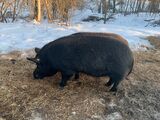the American Guinea Hog

Delicious product
 |
Pasture born and raised |
 |
|
 |
AGH boar |
 |
2024 piglets |
The American Guinea Hog (AGH) can find its roots with some of the earliest settlers in the American South with its origin being possibly over 200 years old! This hardy landrace pig was valued for its ability to thrive on pasture and woodland, excellent temperament and of course its lard. As American's turned to the desire for a faster growing pig and they moved away from natural cooking methods, the Guinea Hog found itself out of favor. Its numbers slowly dwindled and if it wasn't for the dedicated effort of a few people, would have gone extinct.
Today the Guinea's numbers are slowly increasing but it is still listed on the Livestock Conservancy's Threatened list.
This breed was chosen because we wanted an animal that could be fed from what the farmstead produced, without the need for extensive expensive grain inputs and had a good temperament. I did not want a 600# hog that could badly injure someone. The Guinea Hog has a wonderful calm temperament. I’ve handled piglets hours old with the sow not the least bit concerned.
The longer period to market/butcher weight (13-16 months) was of no concern since it could be easily fed on the farmstead's offerings as well as free grain by-products available (spent brewery grains). The flavor of the meat is hard to beat! The lard makes beautiful soap and is a healthy alternative to processed cooking oils.
The Guinea will root but it roots far less than a larger or commercially bred pig. I've found that as long as the grass is growing rooting is at minimum, but as soon as it slows down they pick it up. So to reduce destruction to my pasture I have small "winter lots" that I put the pigs in early October to mid-May. When the hogs then go into their summer pastures, I till up the smaller lots and plant with a variety of plants like turnips, daikon radishes, clover, squashes, oats and more that will provide late summer nutrition and helps me grow the most food for my livestock.
The pigs bred and raised on the Broken H will typically sport a white leg or socks. They are handled soon after birth and are raised on pasture with their mothers, never knowing close confinement except right before being sold, when they are tagged and prepped for their next journey. The sows, boars and barrows being raised for meat can be handled, petted and worked without concern. Average weight at 16 months for my pigs is 160lbs. **I processed 2 13mo gilts in 2024 with hanging weights of 125 and 116. Buyers got around 70lbs of good pork.
If you are looking for a hog to fit into your small homestead, check out the Guinea. In my opinion this pig is almost the perfect Homestead hog.
Learn more about this breed on the AGH website: https://guineahogs.org/guinea-hog-facts
#AmericanGuineaHogs
|